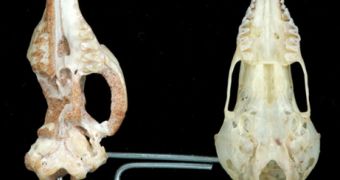The planet made "bang!" and that was all. 65 million years ago, the killer asteroid destroyed all dinosaur life on our planet. But that led to the world of today, filled with placental mammals. This is the conclusion of a new research, in a long debate over when and where these mammals - from rats and whales to humans - first arose. Placentals give birth to a developed new generation, following a long pregnancy, while marsupials (like kangaroos and possums) give birth after a short pregnancy, and monotremes, just like platypuses, lay eggs.
This contradicts a study published in March which based on a DNA study of living mammals, hinted that the lineages leading to modern placentals began to arise millions of years before the dinosaur disappearance. The new research is based on the fossils' study from the past 150 million years compared with living mammals and enhances the idea that modern placental lineages first emerged about 65 million years ago in the Northern Hemisphere.
"This is related to the demise of the dinosaurs. The dinosaurs go extinct, and these various sorts of niches that were occupied by the dinosaurs all of a sudden become open, and it was into those niches that opportunistic placentals evolved." said lead author John Wible, the curator of mammals at the Carnegie Museum of Natural History in Pittsburgh, Pennsylvania.
The researchers focused on a well-preserved shrewlike fossil discovered in the Gobi desert of Mongolia in 1997. The new mammal species - called Maelestes gobiensis - is 71 to 75 million years old, from a time when dinosaurs like the fast-running Velociraptor and the parrot-beaked Protoceratops were roaming the area.
"While Maelestes gobiensis looked generally like a shrew, it is not the direct ancestor of any living mammal. Rather, it represents a side branch of the group of mammals that includes placentals. The new fossil is one of these extinct relatives that falls outside of the main body of the living placental mammals," Wible explained.
The team showed that a few mammal forms living with the dinosaurs about 90 million years ago were extinct rather than radiating into modern placentals, as previously thought. "All the things we're finding in the Cretaceous (144 to 65 million years ago), they're all just extinct end-branches. They're not giving rise to any modern-day groups," Wible said.
David Archibald, a biologist at San Diego State University in California, comes with a different view. "We think some of the Cretaceous [mammals] were harbingers of things to come. A few, not a lot, but a few lineages were showing up at 90 million years." said Archibald.
The DNA research published in March pushed the origin of modern placentals about 100 million years ago, with a second burst of diversification about 35 million years ago.
Various researches changed their hypothesis of this origin from 140 million to 80 million years ago. "The difference is that different teams use different genes for their analysis and different fossils to calibrate their so-called molecular clocks. Paleontologists, by contrast, are limited by a spotty fossil record." said Wible.
"I would not be surprised if I went out tomorrow and in some strata that's around 80 million years I found a placental. But I would be surprised if I went out 125 million years ago and found a placental, which is what some of the molecular papers are telling me as a paleontologist I should be able to do." he added.

 14 DAY TRIAL //
14 DAY TRIAL //